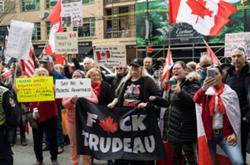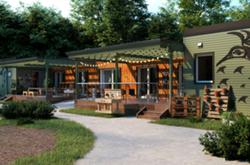
British Columbia is in a race against time to remove and replenish pine stands that have been killed by mountain pine beetle.
At stake is B.C.'s contribution to staving off global warming.
We seem to be making it worse rather than better, despite our vast forests. That is because B.C.'s dead and dying trees are already emitting more carbon dioxide than the living ones are absorbing, according to a report issued Wednesday by Natural Resources Canada.
This means our forests have turned from a net carbon sink into a net carbon source that will emit 990 megatons of greenhouse gases into the atmosphere by 2020.
Yet, at a time when we need it most, planting is expected to decrease next year -- by as many as 70 million seedlings -- as forestry companies curtail silviculture along with other operational expenses. That will be the lowest in two decades, and some analysts project province-wide investment in forest regeneration efforts will continue to fall far short of where it should be.
As a result, say some experts, it is time to rethink how we view the benefits we get from replanting trees in British Columbia, and the way we go about it.
'Eaten in front of our eyes'
David Wilson knows a lot about what goes into a healthy forest. He's been in the silviculture business for 30 years and his Prince George-based company, Celtic Reforestation Services, employs 500 people and operates across British Columbia and Alberta.
"We do everything from reforestation through to silviculture surveys, fire fighting, beetle probing, cone collection, the whole shebang," says Wilson.
His clients include current tenure holders that are required by law to return the land to a free-to-grow state after logging, which means the seedlings have reached a size and health such that they can outgrow surrounding brush.
Wilson says, and the Forest Practices Board confirms, that tenure holders are fulfilling these obligations, which, up to now, have been enough to sustain a thriving lumber industry.
But mountain pine beetle has changed the game. Wilson says there are a significant number of young pine stands -- those planted 15 to 25 years ago -- that are now showing signs of beetle infestation.
"Scientists told us they would never survive in immature trees," says Wilson.
"They are surviving and they are producing brood in them. Twenty-five years of work in our industry is basically being eaten in front of our eyes."
Stumpage system out of date?
According to Ministry of Forests and Range data from a 2007 aerial survey, 157, 360 hectares of young pine stands across the province have been affected by mountain pine beetle.
These young stands represent just a fraction of the total affected area, which equals more than 10 million hectares, but they are an indication of what may become of any future forest stands -- and it's not a pretty picture for long-term investment.
Licenses holders fund reforestation through their stumpage payments.
Stumpage is a complicated formula that basically determines how much a company must pay to the Crown (or First Nations, or another entity) for harvesting on their land.
A portion of this stumpage fee remains in the licensee's possession in order to fund silviculture activities, but in the current market slump these have been curtailed along with logging and mill operations.
"Right now silviculture is being driven by the lumber markets," says Wilson. "It shows up on the cost side . . . it's being practiced aggressively when markets are good, when they're not it's not being practiced very aggressively.'
"In my opinion, that's not the way to manage a system for future growth."
If license holders don't log, they aren't obligated to reforest. Now there are concerns that major tenures will simply become inactive as forest companies pull out of British Columbia and invest in mills elsewhere.
Firms buying mills outside BC
Last December, Pope and Talbot Inc. filed for bankruptcy, affecting four sawmills and two pulp mills in B.C.
That put the brakes on a proposed $240 million bio-energy plant at Pope and Talbot's Mackenzie pulp mill. The power developer involved in the deal, Pristine Power, has found more success on a small scale.
Plans are underway for a "bio-energy network;" up to 20 10-megawatt gasification plants across the province that will each feed off sawmill waste and slash piles within a 100-kilometre radius.
When Pristine approached Carrier Lumber Ltd. about producing electricity from its wood waste, it was a "dream come true," says Don McMillan, the general manager of one of Carrier's mills.
Although partnerships with bio-energy plants may help sawmills offset the costs of harvesting, then replanting and maintaining new stands, it's likely only feasible on a small scale because long hauling distances hike up costs.
Major lumber companies like Canfor, accustomed to billion-dollar profits, aren't investing in bio-energy in a big way and are looking for greener pastures elsewhere. In 2006, it purchased two major lumber companies in the southeast U.S., and was prepared to mount a defense against potential takeovers last year.
There are greener pastures elsewhere. Russia, for example, is attracting more forest company investment as a result of tax policy changes. In 2007, the Russian government announced that its 6.5 per cent export tax on raw logs, issued two years earlier in order to stimulate domestic log processing, was about to go up.
Now at 25 per cent, it is set to increase to 80 per cent on Jan. 1, 2009.
One equipment manufacturer in Prince George is doing good business furnishing plants there.
"Companies like Weyerhauser and Proctor and Gamble are moving into Russia," says Brian Fehr of Delltech manufacturing.
"They're building three or four pulp mills at a time, three or four OSB [oriented strand board, a type of engineered wood] plants at a time."
"Is it reasonable to expect these companies are going to be around, and if they leave, who's responsible for anything that goes wrong on those public lands?" asks Ben Parfitt, a resource policy analyst with the Canadian Centre for Policy Alternatives.
Who is responsible for replenishing?
Parfitt, a long-time writer on forestry issues, says there is a "black hole" in terms of who is responsible for lands that are not adequately stocked with healthy trees, but no longer the responsibility of any license holder.
"We have a tremendous challenge moving forward in terms of what species we plant, and where and why, given warming projections," says Parfitt.
Even if B.C. makes a significant transition to forests raised for biofuel, Parfitt wonders how that will insure healthy, diverse forests capable of absorbing large amounts of carbon.
"Are [bio-energy entrants] really well-equipped to do that reforestation? Are they prepared to foot the costs of doing that work?" he asks.
"Or should the province itself be perhaps taking over responsibility for reforestation?"
Crown is 'ramping up' planting
The province does have a program, Forests for Tomorrow, which targets areas that licensees will not be harvesting.
"The crown is taking responsibility to replant those areas," says deputy chief forester Craig Sutherland.
Sutherland says the program is "ramping up" and currently spends approximately $45 to $50 million per year to plant seedlings in areas where licensees aren't active.
"Between 10 and 15 million trees per year will be planted," says Sutherland. "It will continue until we've got it all caught up."
According to the Western Silvicultural Contractor's Association (WSCA), this year's planting program has declined by 25 million seedlings since last year.
Their analysis of sowing trends, released early this year, is based on sowing request information of the Ministry of Forests' seed planning and registry application.
The report notes that planting was at a record high last year, but states the prognosis for the next two years is "troubling."
"Although the orders for 2009 are not yet complete, the spring-planting orders have now been placed for only 171 million seedlings -- a decline of 37 million seedlings from the expected 2008 planting programme.
"Assuming the continual decline of summer-ship seedlings, the total 2009 planting program will be about 200-million seedlings -- a 20-year low in seedling production and planting activities."
Separate planting and processing
Wilson says he believes it's time for the silviculture aspect of forestry to be separated from forest product processing.
"There are all different kinds of ways to fund silviculture . . . the end user could pay, the logger could pay in stumpage, the purchase of the log could pay, it could be paid for by taxation," he says.
"In any case, it should be a crown responsibility or it should be given to another body that is specifically charged with providing the highest silviculture return to the crown."
This would require major changes to the current tenure system. Although virtually all stakeholders in forestry have been calling for tenure reform for years, it's not an easy task for any jurisdiction to undertake.
"Government is prone to incremental measures," says Bruce Fraser, chair of the Forest Practices Board.
"They are gatekeepers of convention that don't want to take huge risks."
Experiments called for
Fraser says we need to be taking some risks right now, in order to figure out what to do silviculturally to ensure there are forests in the future given mountain pine beetle fallout and climate change.
"Some may lose capacity to grow timber, some may change the nature of the species that grow there," says Fraser. "We need a zone to experiment."
Fraser says although softwood lumber might not be British Columbia's cash crop of the future, these experimental zones may identify other forest-based resources.
John Betts, executive director of the WSCA, says forest health should be the overarching principal of forest practices, instead of having different industries managing for whatever commodity they produce.
"I think the huge lesson of the mountain pine beetle is that we have to view the forests and landscape as a dynamic ecosystem," says John Betts, executive director of the WSCA.
"We have this notion that trees are just tubes of carbon or tubes of fibre . . . we seem to make this mistake all the time of viewing the landscape as some form of commodity."
Related Tyee stories:
- Selling Doomsday Debits
In BC's wasteful forest biz, carbon credits don't grow on trees. - Burn Trees to Light Homes?
Europe imports BC wood pellets to create 'bioenergy.' Here, it's not so easy. - Sharing the Forests
In new timber deals, what are First Nations really getting?
Read more: Labour + Industry, Environment
















Tyee Commenting Guidelines
Comments that violate guidelines risk being deleted, and violations may result in a temporary or permanent user ban. Maintain the spirit of good conversation to stay in the discussion.
*Please note The Tyee is not a forum for spreading misinformation about COVID-19, denying its existence or minimizing its risk to public health.
Do:
Do not: